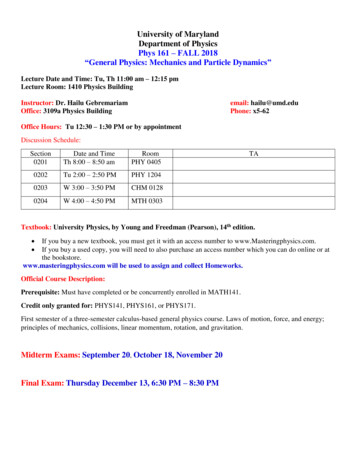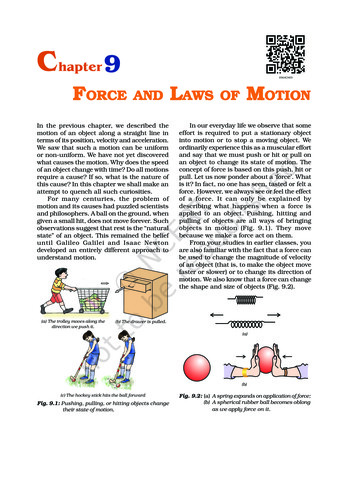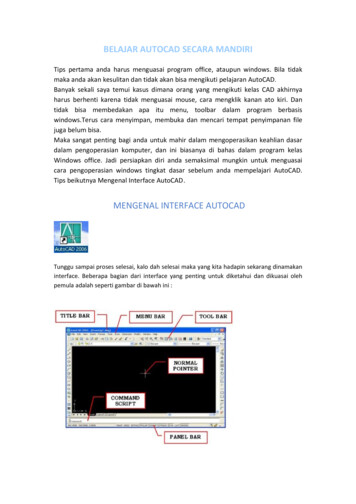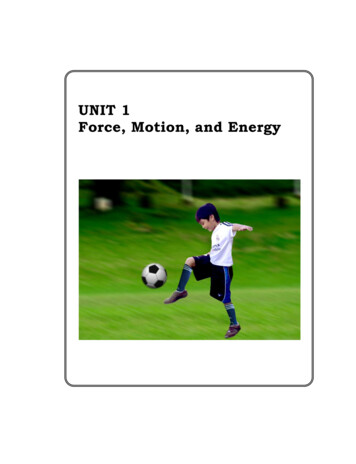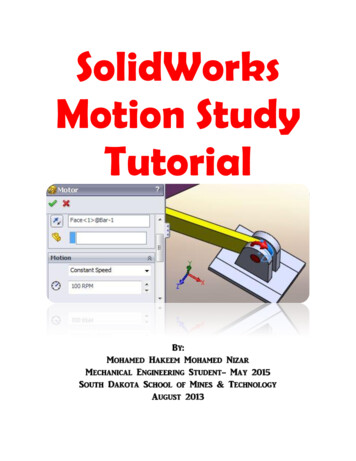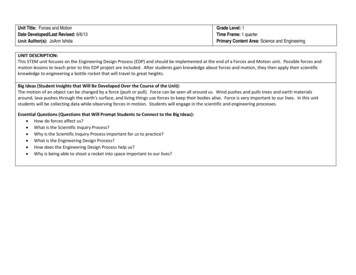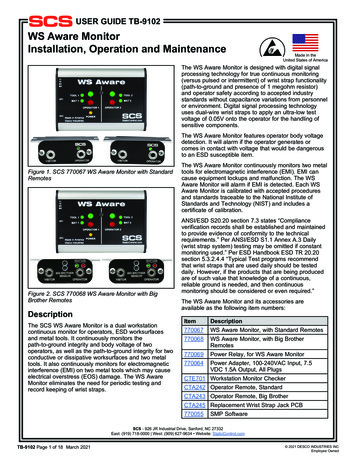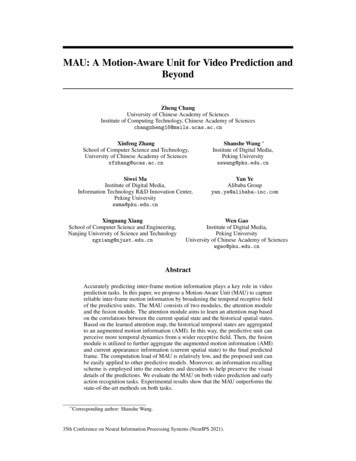
Transcription
MAU: A Motion-Aware Unit for Video Prediction andBeyondZheng ChangUniversity of Chinese Academy of SciencesInstitute of Computing Technology, Chinese Academy of Scienceschangzheng18@mails.ucas.ac.cnXinfeng ZhangSchool of Computer Science and Technology,University of Chinese Academy of Sciencesxfzhang@ucas.ac.cnSiwei MaInstitute of Digital Media,Information Technology R&D Innovation Center,Peking Universityswma@pku.edu.cnXinguang XiangSchool of Computer Science and Engineering,Nanjing University of Science and Technologyxgxiang@njust.edu.cnShanshe Wang Institute of Digital Media,Peking Universitysswang@pku.edu.cnYan YeAlibaba Groupyan.ye@alibaba-inc.comWen GaoInstitute of Digital Media,Peking UniversityUniversity of Chinese Academy of Scienceswgao@pku.edu.cnAbstractAccurately predicting inter-frame motion information plays a key role in videoprediction tasks. In this paper, we propose a Motion-Aware Unit (MAU) to capturereliable inter-frame motion information by broadening the temporal receptive fieldof the predictive units. The MAU consists of two modules, the attention moduleand the fusion module. The attention module aims to learn an attention map basedon the correlations between the current spatial state and the historical spatial states.Based on the learned attention map, the historical temporal states are aggregatedto an augmented motion information (AMI). In this way, the predictive unit canperceive more temporal dynamics from a wider receptive field. Then, the fusionmodule is utilized to further aggregate the augmented motion information (AMI)and current appearance information (current spatial state) to the final predictedframe. The computation load of MAU is relatively low, and the proposed unit canbe easily applied to other predictive models. Moreover, an information recallingscheme is employed into the encoders and decoders to help preserve the visualdetails of the predictions. We evaluate the MAU on both video prediction and earlyaction recognition tasks. Experimental results show that the MAU outperforms thestate-of-the-art methods on both tasks. Corresponding author: Shanshe Wang.35th Conference on Neural Information Processing Systems (NeurIPS 2021).
1IntroductionVideo prediction is a representative task in video predictive learning area, which aims to predict theunknown future on the basis of the limited knowledge and has been applied in a wide range of researchareas, such as robotic control [1], video interpolation [2], autonomous driving [3], motion planning[4] and so on. However, compared with images, videos are more complex due to the time-varyingmotion information and predicting reliable motion information has always been a significant butchallenging problem for video prediction tasks. Fortunately, deep learning technologies have showntheir great power in learning meaningful features for multimedia data and have achieved great successin computer vision and natural language processing tasks. Motivated by this, learning-based methodshave been applied for video prediction in recent years.Recurrent neural networks (RNNs) are first applied to learn video representations due to their uniqueadvantages in modeling sequential data [5]. Then the Long Short-Term Memory (LSTM) [6] andGated Recurrent Unit (GRU) [7] are integrated into RNNs to help capture more reliable inter-frametemporal dependency [1, 8, 9, 10, 11, 12, 13, 14, 15]. In general, to save the computation resourcesand help predictive units to better perceive visual information, the fully connected layers in thepredictive memories are replaced by convolutional layers in the above methods. Although the spatialreceptive field of the unit has been improved by the integrated convolutional layers, the temporalreceptive field is still narrow, and it is difficult for the unit at current time step to perceive whathas happened in a longer past, which severely restrict the model expressivity to inter-frame motioninformation and the performance in predicting videos with complex scenarios and high resolutions isfar from satisfactory.Some works have attempted to broaden the temporal receptive field for the predictive units using3D convolutional layers [16, 17]. However, the temporal receptive field is mainly determined by thekernel size of the integrated convolutional operators and the temporal dimension still needs to be set toa small value to meet the computation load requirement. Since then, the explorations for broadeningthe temporal receptive field for predictive models have been shelved and a variety of works beginto explore other ways to improve the expressivity of the model on videos with complex scenarios,which can be roughly categorized into two types, the structure-oriented methods and the loss-orientedmethods. The structure-oriented methods utilized deep stochastic models to predict different futuresfor different samples based on their latent variables [18, 19, 20, 21]. However, the computation loadof these methods is typically high, preventing their practicability in real world. And the loss-orientedmethods aim to improve the traditional mean square error (MSE) based loss functions to generatemore naturalistic results. Generative adversarial networks (GANs) [22, 23, 24, 25], perceptual loss[26] and so on have been utilized to generate results with higher perceptual quality. In spite ofthe explorations made by the above methods, only limited model performance improvements havebeen achieved and the unsatisfactory temporal receptive field still restricts the model performance incapturing reliable motion information between frames.To solve the above problem, we propose the Motion-Aware Unit (MAU) to improve the modelexpressivity in capturing motion information by efficiently broadening the temporal receptive field.In particular, for each MAU, two modules are designed, the attention module and the fusion module.The attention module is designed for efficient attention and the fusion module is designed for efficientfusion. In particular, the attention module aims to help the unit to pay different levels of attentionto the temporal states in the broadened temporal receptive field based on the corresponding spatialcorrelation scores. Using the attention scores, the temporal states can be aggregated to a more reliableaugmented motion information (AMI) with a low computation load. The fusion module aims tofurther aggregate the augmented motion information (AMI) and the appearance information (thespatial state from current time step) using only two update gates. Moreover, an information recallingscheme is applied to further preserve the visual details of the predictions. Experimental results showthat the proposed MAU can outperform other state-of-the-art methods on both video prediction andearly action recognition tasks.2Related WorkIn this section, we introduce the learning-based video prediction methods in detail. Due to the uniquepower in modeling sequential data, RNNs are first utilized to model videos. Ranzato et al. [5] utilizedRNNs to propose a baseline model for unsupervised feature learning on video data. Srivastava et al.2
[8] further integrated Long Short-Term Memories (LSTMs) [6] into RNN-based models to capture thetemporal long-short term dependencies for videos, which is denoted as FC-LSTM. However, the fullyconnected layers in FC-LSTM are computation-expensive, which limits its practicability in real world.To further reduce the computation load and increase local perceptions to visual data for LSTMs, Shiet al. [9] proposed the ConvLSTM by replacing the fully connected layers with convolutional layers.Ballas et al. [10] further integrated convolutional layers into Recurrent Gated Unit (GRU) [7], denotedas ConvGRU, which has achieved a similar performance but with lower computation load comparedwith ConvLSTM. Motivated by the success achieved from the above video prediction methods, RNNshave been further explored to predict videos with higher visual quality and video prediction modelsare beginning to be applied into more research areas, such as robotics [1], precipitation nowcasting[11] and so on. However, the above works merely focus on exploring the temporal dependency butignore the spatial features for videos. Wand et al. proposed PredRNN [13] to solve this problemby adding a spatial information processing module for ConvLSTMs. And to solve the gradientpropagation difficulties in PredRNNs, Wang et al. further designed a Gradient Highway Unit [14]and the new model was denoted as PredRNN .Although the above RNN-based models have achieved some satisfactory results, the datasets utilizedare either with simple scenarios or low resolutions and the model performance on videos withcomplex scenarios and high resolutions is still far from satisfactory. One main reason for this is thatthe predicted frames at current time step still mainly depend on the inputs from current time stepand the temporal receptive field of the predictive model is narrow, which is not enough to predictreliable motion information for the next time step. To solve this problem, Wang et al. employed3D convolutional layers into PredRNNs and utilized multi-term temporal states to help increasetemporal receptive field for the predictive unit, which is denoted as E3D-LSTM [16]. However, thecomputation load of E3D-LSTM is extremely high due to the integrated 3D convolutional operatorsand the recall gate. To further improve the model expressivity for the predictive models, many othermethods have also been proposed, which can be summarized into four types. The first type aims toprotect the visual details for the predictions [12, 17, 27, 28]. The second type aims to predict differentfutures rather than an averaged future for each sample based on their latent variables [18, 19, 21].The third type aims to refer to deeper models to increase the model expressivity [20, 29, 30]. And thelast type aims to improve the loss functions to generate more naturalistic results [22, 23, 24, 25, 26].However, in the above methods, the temporal receptive field problem was still not fully explored. Inthis paper, we propose the motion-aware unit (MAU), which can efficiently broaden the temporalreceptive field to predict more reliable motion information for videos and the computation load isrelatively low. In addition, MAU can be easily employed in other predictive models.33.1MethodProblem formulationA video prediction model typically takes a video clip {v1 , ., vi } as the inputs and outputs the futurevideo clip {v̂i 1 , ., v̂T }. And we want to optimize the following problem,minTX[D(v̂t , vt )],(1)t i 1where v̂t denotes the predicted frame at time step t, D denotes the loss function, such as the L1 , L2loss functions and so on.To optimize the above problem, the error between the predicted frame v̂t and the ground truth vtis expected to be as small as possible. For most of the RNN-based video prediction methods, theframes are usually progressively predicted where the proposed model predicts one frame for eachtime step. In particular, the predicted frame v̂t depends on the spatial information, i.e. the frame inputat the previous time step vt 1 and the temporal information, i.e. the transited motion informationTt 1 . However, as the time steps move on, the predicted error in Eq. 1 dramatically accelerates dueto the increasing uncertainty of the transited temporal information Tt 1 . To solve this problem, thepredictive unit needs to search for more useful temporal information from a wider range of time steps,i.e. the temporal receptive field is needed to be broadened. For time step t, the temporal receptivefield is probably to be set as t 1. However, it may be not efficient and necessary to utilize all theprevious frames, thus the receptive field is more likely to be set to a fixed value τ . Although recent3
vˆt 1RecallMotion-Aware UnitDecoderMAUTtk- t2:t -1Sk -1t -t :t -1gDotProductSoftmaxMULUsSUMTtk 21-1-TattStk- t1:t -1Stk 1MAUATTAttention MapStk 2MAUHadamardProductStk -1ATTStk1-Ttk-t :t -1Ttk-1UfTAMIUtTtkEncodervtAttention ModuleFusion ModuleFigure 1: Left: The structure of the predictive network with stacked MAUs. Right: The structure ofthe proposed motion-aware unit: MAU. Ttk denotes the temporal state at time step t from layer k.Stk denotes the spatial state at time step t from layer k. SUM and MUL represent summation andmultiplication.work E3D-LSTM [16] has attempted to address this problem and the temporal receptive field isbroadened, the computation load is extremely high with only a limited performance improvement(mainly achieved by the integrated 3D convolutional layers), which indicates the broadened temporalreceptive field may not been fully used.To ensure that the broadened temporal receptive field can be fully utilized, two problems are neededto be solved, The temporal states in current receptive field should be aggregated according to theirimportance. The motion information from the aggregated temporal state and the appearance informationfrom the spatial state should be fused reasonably.To solve the above two problems, we propose the Motion-Aware Unit (MAU) and the predicted framev̂t can be represented as follows,v̂t Dec[M AU (Enc(vt τ :t 1 ))],(2)where Enc(·) denotes the encoder which is utilized to extract deep features from the video input andDec(·) denotes the decoder which is utilized to map the predicted features to the frames. M AU (·)denotes the proposed motion-aware unit, which will be detailedly introduced in Section 3.2.3.2The proposed Motion-Aware Unit: MAUIn this section, we introduce the structure details of MAU, as shown in Fig. 1 (right). Each MAUconsists of two modules: the attention module and the fusion module. Typically, to improve themodel expressivity, multiple MAUs are stacked, as shown in Fig. 1 (left). In particular, at time step tkin layer k, two inputs will be fed into the MAU: the temporal states set Tt τ:t 1 from previous τk 1time steps and the spatial states set St τ :t from previous τ 1 time steps.To solve the first problem in Section 3.1, we design the attention module, which aims to help thepredictive unit to pay different levels of attention to different historical temporal states. The expectedsituation is that the predictive can always pay the highest level of attention to the most correlatedstates. Now the problem comes to how to quantify the correlations between different temporal states.Considering the fact that the visual quality of each frame can be the most factors to evaluate a videoprediction model, the correlations between the corresponding spatial states can be an optimal choice.4
kBased on the analysis, the attention score αj for the temporal state Tt jcan be denoted as follows,eqjαj Pτi 1eqi,k 1qi SU M (St i S ′ ),S ′ Ws i 1, ., τ,Stk 1 ,(3)where , denote the Hadamard product and the convolutional operator, respectively. Using thecomputed attention score, the temporal state set can be aggregated as follows,Tatt τXkαj · Tt j.(4)j 1Tatt can be treated as the long-term motion information. However, besides the long-term motionkinformation Tatt , the short-term motion information Tt 1is also needed to be utilized to strengthenthe final motion information. We define a fusion gate Uf to control the fusion process, which can beshown as follows,kUf σ(Wf Tt 1),kTAM I Uf Tt 1 (1 Uf ) Tatt ,(5)where σ denotes the sigmoid function, TAM I denotes the augmented motion information.To solve the second problem in Section 3.1, we design the fusion module to aggregate the motioninformation in the augmented motion information TAM I with the appearance information in thecurrent input Stk 1 . To control the fusion ratios for both temporal and spatial information, two updategates are denoted as follows,Ut σ(Wtu TAM I ),Us σ(Wsu Stk 1 ),(6)where Ut denotes the temporal update gate and Us denotes the spatial update gate. Using both gates,the aggregating process can be conducted as follows,Ttk Ut (Wtt TAM I ) (1 Ut ) (Wst Stk 1 ),Stk Us (Wss Stk 1 ) (1 Us ) (Wts TAM I ) γ · Stk 1 ,(7)where the residual-like term γ · Stk 1 is utilized to stabilize the training process.In particular, as shown in Fig. 1 (left), the frame input vt is encoded to deep features by the encoderand the predicted spatial state is decoded back to the frame by the decoder, represented as follows,S0t Enc(vt ),v̂t 1 Dec(StN ),(8)where N denotes the total number of the employed MAUs.3.3Information recalling schemeConsidering the information loss problem during encoding, an information recalling scheme betweenencoders and decoders have been employed, which is defined as the information recalling schemeand can be represented as follows,Dl Decl (Dl 1 E l ),l 1, ., N,(9)where Dl , E l denote decoded features from the lth layer of the decoder and the encoded featuresfrom the lth from the last layer of the encoder. Decl denotes the lth layer of the decoder. On the basisof the above information recalling scheme, the decoders can recall multi-level encoded informationback and the visual quality of the predictions is better.5
InputsGroundTruthMAUE3D-LSTMPredRNN PredRNNConvLSTMFigure 2: The qualitative results from different methods on the Moving MNIST dataset.4Experiments4.1ImplementationsWe evaluate the proposed MAU on five datasets, the Moving MNIST dataset [8], the KITTI dataset[31], the Caltech Pedestrian dataset [32], the TownCentreXVID dataset [33] and the SomethingSomething V2 dataset [34]. The number of the hidden state channels of MAUs are set to 64 and theintegrated convolutional operators are set with a kernel size 5 5 and stride 1. All experiments areoptimized with the Adam optimizer. To stabilize the training process, we employ layer normalizationoperators after each integrated convolutional layer in MAUs.4.2Video PredictionWe conduct video prediction experiments on the the Moving MNIST dataset, the KITTI dataset, theCaltech Pedestrian dataset, and the TownCentreXVID dataset. The detailed experimental settings aresummarized in Table 1. All models are optimized with the MSE loss function.Table 1: Experimental settings. MAUs denotes the number of the stacked MAUs. Train and Testdenotes the number of frames as the inputs and the outputs while training and testing.DatasetResolutionMoving MNIST1 64 64KITTI & Caltech 3 128 160TownCentreXVID 3 1088 19204.2.1MAUs Hidden channels Kernel41616646464TrainTestτ γ5 5 10 10 10 10 5 0.05 5 10 1 10 10 5 1.05 5 4 1 4 4 5 1.0Moving MNISTThe Moving MNIST dataset can be the most widely-used dataset in video prediction, where eachsequence consists of 20 successive frames with 2 digits randomly placed. Each frame is with a sizeof 64 64. In our experiments, sequences are generated from the training set of the standard MNISTdataset [35] and we utilize the test set collected by Srivastava et al. [8] to evaluate the proposedmodel. The Mean Square Error (MSE), the Structural Similarity Index (SSIM) are employed toindicate the visual quality of the predictions.Fig. 2 shows the visual results predicted from different methods, where the proposed MAU significantly outperforms other methods, especially for the prediction in the last two time steps. Table 2summarizes the quantitative scores of the predictions from different methods. The proposed MAU hasachieved the best scores compared with other state-of-the-art methods. And the employed recallingscheme can help further improve the model performance.In addition, the parameters and inference time are also recorded in Table 3. For a fair comparison,all models are implemented with the same encoder and decoder with the same number of predictiveunits. In particular, for the proposed MAU, the recalling scheme is disabled and all models are trained6
Table 2: Quantitative results of different methods on the Moving MNIST dataset (10 frames 10 frames). Lower MSE and higher SSIM scores indicate better visual quality. The results of thecompared methods are reported in [36].Moving MNISTSSIM/frame MethodMSE/frame ConvLSTM (NeurIPS2015) [9]FRNN (ECCV2018) [12]VPN (ICML2017) [29]PredRNN (NeurIPS2017) [13]PredRNN (ICML2018) [14]MIM (CVPR2019) [15]E3D-LSTM (ICLR2019) [16]CrevNet (ICLR2020) 8.470.056.846.544.241.338.5MAU (w/o recalling)MAU0.9310.93729.527.6Table 3: Ablation study on the Moving MNIST dataset (10 frames 10 frames). For fair comparison,the encoders and decoders are with the same structure for all models and All models are trained usingAdam optimizer based on the MSE loss.MethodBackboneMSE SSIM Parameters Inference timeConvLSTM (NeurIPS2015) [9]4 ConvLSTMs 102.1ST-LSTM (NeurIPS2017) [13]4 ST-LSTMs54.5Casual-LSTM (ICML2018) [14] 4 Casual-LSTMs 46.3MIM (CVPR2019) [15]4 MIMs44.1E3D-LSTM (ICLR2019) [16]4 E3D-LSTMs 40.1RPM (ICLR2020) [17]4 RPMs42.0MotionGRU (CVPR2021) [28]4 MotionGRUs .21s18.01s17.58s29.50.9310.78M17.34sMAU4 MAUsTable 4: Model performance of MAU with different temporal receptive field τ . In particular,γ 0, λ 0. The percentage values are calculated based the MAU with τ 1.MSE/frameInference timeτ 1τ 3τ 5τ 1033.414.90s32.2 ( 3.6%)15.85s ( 6.4%)29.5 ( 11.7%)17.36s ( 16.5%)29.3 ( 12.3%)20.23s ( 35.8%)using Adam optimizer based on the MSE loss. We record the parameters for a single unit and theinference time is recorded over 800 samples. The summarized results show that the MAU can achievethe best scores with the fewest parameters and a relatively low computation load.Table 4 shows the model performance with different temporal receptive field τ (w/o recalling).Although the quality of the predictions becomes better as the temporal receptive field increases, thecomputation load also dynamically increases. Thus, τ is typically set to an appropriate value toachieve a satisfactory trade-off between the visual quality and the computation load. In particular, weset τ 5 in this paper.4.2.2KITTI and Caltech Pedestrian datasetsWe use two car-mounted camera video datasets to evaluate the performance of MAU in real scenarios.KITTI and Caltech Pedestrian datasets are very similar to the real-world scenarios, which are collectedto train the autonomous vehicles.We follow the experimental settings in [37], where all frames are cropped and resized to 128 160.The proposed model is trained on the KITTI dataset and tested on the Caltech Pedestrian dataset. In7
particular, the frame rate of the Caltech Pedestrian dataset is adjusted to the same as KITTI (10 fps).A total of 32373 sequences are for training and 7725 sequences for testing. In addition, the proposedmodel is trained to predict the next frame with the first 10 frames as the inputs. While testing, thetemporal period of the predictions is extended to 10 frames.Inputst 5t 10t 11t 12t 13Predictionst 15t 16t 14t 17t 18t 19t 20MAUJin et al.(CVPR2020)CrevNet(ICLR2020)Figure 3: The qualitative results from different methods on the Caltech Pedestrian dataset.Table 5: Quantitative results of different methods on the Caltech Pedestrian dataset. Lower MSE,LPIPS scores and higher SSIM, PSNR scores indicate better frame-level visual quality (10 frames 1 frame). Lower FVD score indicates better sequence-level visual quality (10 frames 10 frames).The results of the compared methods are partially reported in [36].MethodCaltech PedestrianMSE(10 3 ) SSIM PSNR LPIPS(10 2 ) FVD/10 frames BeyondMSE (ICLR2016) [26]MCnet (ICLR2017) [38]CtrlGen (CVPR2018) [39]PredNet (ICLR2017) [37]ContextVP (ECCV2018) [40]E3D-LSTM (ICLR2019) [16]Kwon et al. (CVPR2019) [24]CrevNet (ICLR2020) [17]Jin et al. 2451.62311.21663.21709.61441.1MAU (w/o 9.91204.0Fig. 3 shows the generated examples from the proposed MAU and two latest state-of-the-art methods.From the visual results, the proposed MAU can predict more clear traffic signs (t 16), whichindicates the MAU can capture more reliable temporal dynamics for videos. Table 5 shows thequantitative results from different methods, where the proposed MAU outperforms other methods inall scores. In particular, the recalling scheme can further improve the model performance.4.2.3TownCentreXVIDIn this section, we evaluate the proposed model on a surveillance dataset, TownCentreXVID, whichis more close to the real scenarios and with a resolution of 1920 1080. TownCentreXVID datasetcontains a total of 7500 frames. To further evaluate the model performance in predicting highresolution videos, all frames are not resized. The first 4500 frames are for training and the last 3500frames are for testing. Fig. 4 shows the visual results from different methods, where the proposedmethod can generate much better visual details compared with other state-of-the-art methods.We further conduct object detection tasks on the predictions from different methods using the pretrained Yolov5s model [41] and the results are shown in Fig. 5. More persons have been detected bythe pre-trained Yolo model from the predictions generated from MAU and the confidence is higherthan others.8
E3D-LSTM (ICLR2019)CrevNet (ICLR2020)MAUGround TruthFigure 4: Qualitative results from different methods on the TownCentreXVID dataset (4 frames 1frame).0.870.83E3D-LSTM (ICLR2019)0.83 0.800.860.86CrevNet (ICLR2020)0.89MAU0.87 0.91Ground TruthFigure 5: Object detection experiments on the predictions (4 frames 1 frame) from differentmethods using Yolov5s pre-trained model [41]. Confidence threshold is set to 0.8.Table 6: Quantitative results of different methods on the TownCentreXVID dataset (4 frames 4 frames). Higher SSIM and PSNR scores indicate better objective quality. Lower LPIPS scoreindicates better perceptual quality.TownCentreXVIDt 5Methodt 8PSNR SSIM LPIPS(10 2 ) PSNR SSIM LPIPS(10 2 ) ConvLSTM (NeurIPS2015) [9]PredRNN (NeurIPS2017) [13]PredRNN (ICML2018) [14]E3D-LSTM (ICLR2019) [16]CrevNet (ICLR2020) 3.70MAU (w/o 140.9130.94232.4212.89In addition, Table 6 summarized the detailed quantitative results from MAU and other methods,where MAU has achieved the best objective (PSNR, SSIM) and perceptual (LPIPS) scores.4.3Early action recognition: Something-Something V2The Something-SomethingV2 dataset is a large collection of labeled video clips that show humansperforming pre-defined basic actions with everyday objects. The whole dataset consists of 174categories of videos. The training set contains 168,913 videos and the validation set consists of24,777 videos. The resolution of each video is 240 427. To further evaluate the performancein modeling high-level spatiotemporal representations for videos, the early action recognition taskis conducted, which aims to categorize the whole video after observing only the front part of thevideos. To accurately predict an activity category for current video, models need to extract usefulspatiotemporal representations from merely the front part of the whole frames to predict a reliablefuture. In particular, we utilize the front 25% and 50% frames of each video to conduct this task,respectively. For each video, a total of 20 frames are sampled which can cover the whole temporalperiod. Each frame is resized to 128 128. For 25% early action recognition task, 5 frames are as9
the inputs to predict the next 15 frames. For 50% early action recognition task, 10 frames are as theinputs to predict the next 10 frames.All models are first pre-trained to perform video prediction task with the front 25% or 50% framesas the inputs to predict the remaining 75% or 50% frames. After convergence, a total of 19 hiddenstates extracted from the pre-trained models are concatenated to train the classifier, which consistsof 3 3D convolutional layers. In particular, the concatenated hidden states are transformed fromC T H W : 64 19 16 16 to 174 1. To evaluate the performance of different predictiveunits in modeling spatiotemporal representations for videos, we utilize various predictive units asthe backbone of the early action recognition model. For fair comparison, the encoder, decoder andclassifier are set with the same structure for all models. A total of 16 predictive units are stacked forall models. The experimental results are summarized in Table 7. On the one hand, the predictivemodel with MAU has achieved the best PSNR score of the predictions. On the other hand, based onthe learned spatiotemporal representations from the pre-trained models, the proposed MAU can alsoobtain the highest Top1 and Top5 accuracies.Table 7: The results of the early action recognition experiment of different methods on the SomethingSomething V2 dataset.Method5Something-SomethingV2Front 25%Front 50%PSNR top-1 top-5 PSNR top-1 top-5 ST-LSTM (NeurIPS2017) [13]Casual-LSTM (ICML2018) [14]E3D-LSTM (ICLR2019) [16]RPM (ICLR2020) [17]MotionGRU (CVPR2021) 7.365.4019.0018.4710.6030.90ConclusionWe proposed the Motion-aware Unit (MAU) for video prediction and beyond. The motion-awareunit can take advantage in the broadened temporal receptive field, where more temporal statescan be simultaneously perceived. In particular, the proposed unit are constructed based on theattention mechanism, which consists of two modules, the attention module and the fusion module.In particular, the attention module can extract attention weights from multi-term s
University of Chinese Academy of Sciences wgao@pku.edu.cn Abstract Accurately predicting inter-frame motion information plays a key role in video prediction tasks. In this paper, we propose a Motion-Aware Unit (MAU) to capture reliable inter-frame motion information by broadening the temporal receptive field of the predictive units. The MAU .


